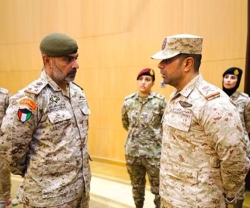The Pentagon's announcement resolved questions about the fate of Captain Michael Scott Speicher, who some believed had survived his shoot-down and been taken prisoner by Iraq.
Bone fragments and skeletal remains were recovered in the desert last week by US Marines stationed in Iraq's Anbar province, thanks to a tip from an Iraqi citizen, the department said. It said they were identified as Speicher's by the Armed Forces Institute of Pathology.
Speicher's F/A-18 Hornet fighter was shot down over west-central Iraq on Jan. 17, 1991, the first night of the first Gulf War, which eventually drove Iraqi leader Saddam Hussein from Kuwait.
An official Navy history identified Speicher as the first American casualty of the conflict. Some reports had emerged that Speicher, 33 when he was downed, might have survived and become a captive of Saddam.
On Jan. 11, 2001, Speicher's status was changed from killed in action to missing in action.
The US intelligence community had concluded that Baghdad could account for Speicher's fate but was concealing information, according to an unclassified summary of its findings released in March 2001.
President George W. Bush, in a Sept. 12, 2002, speech to the U.N. General Assembly, had cited Speicher's possible detention as part of his case for post-Sept. 11 action against Iraq, along with allegations that Saddam was developing banned weapons of mass destruction and was sponsoring terrorism.
President Barack Obama said he was grateful to the Marines who pursued the information that led to the recovery of Speicher's remains "so that he can now come home."
"My thoughts and prayers are with his family, and I hope that the recovery of his remains will bring them a needed sense of closure," Obama said in a statement.
The Iraqi government had maintained from the start that Speicher died in the January 1991 crash, although his remains had gone unrecovered, fueling conspiracy theories.
The Iraqi who told Marines about the remains said he knew of two Iraqi citizens who recalled a US jet crashing in the desert. One said he had been present when Speicher was found dead at the site and buried there by Bedouin tribesmen. The Iraqis led the Marines to the crash site.
"Positive identification was made by comparing Captain Speicher's dental records with the jawbone recovered at the site," a Pentagon statement said. "The teeth are a match, both visually and radiographically."
Admiral Gary Roughead, chief of Naval Operations, said: "Our Navy will never give up looking for a shipmate, regardless of how long or how difficult that search may be."
"We owe a tremendous debt of gratitude to Captain Speicher and his family for the sacrifice they have made for our nation and the example of strength they have set for all of us," he said in the statement put out by the Pentagon.






















